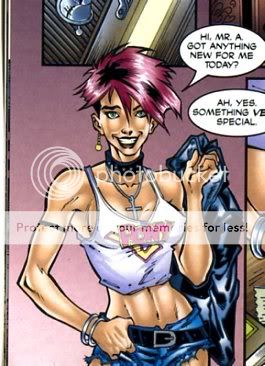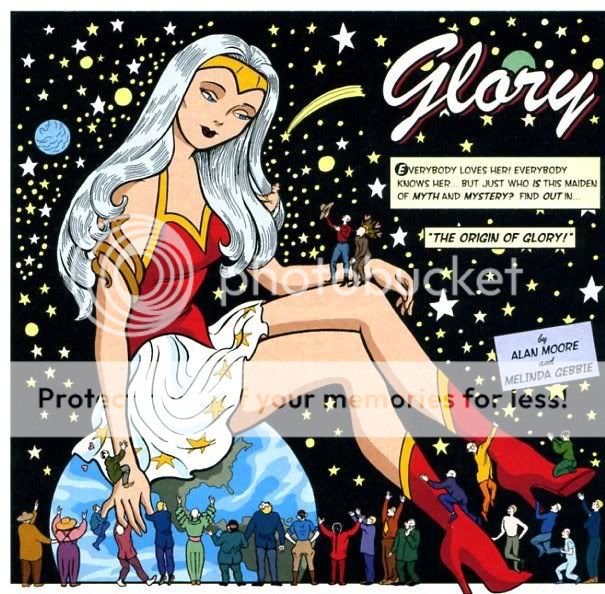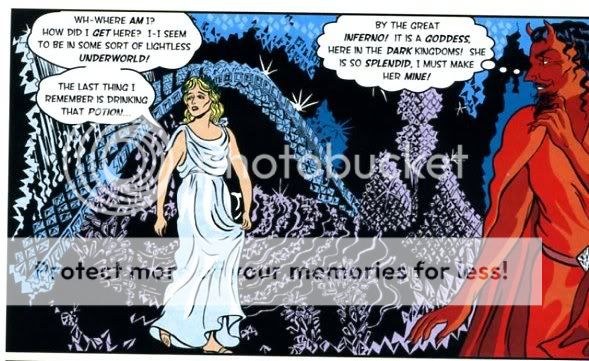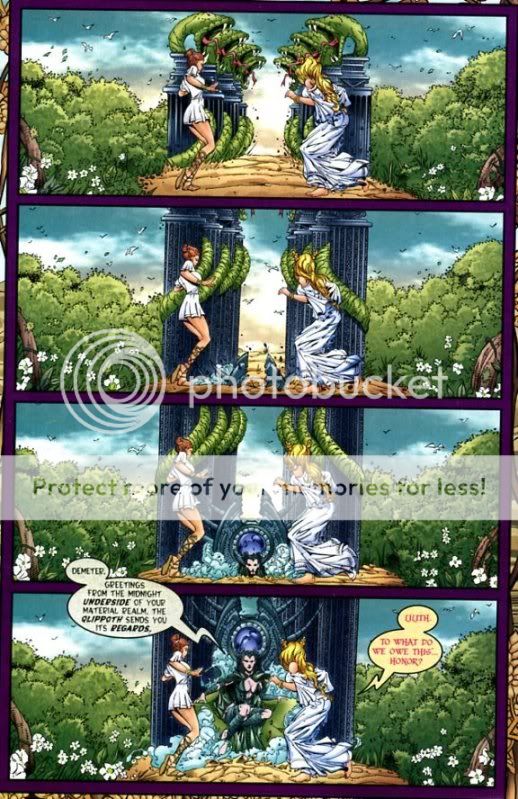I’d posted a bit back about Alan Moore’s proposal for Glory. Basically I argued that for the most part Moore didn’t seem to understand what made the Marston/Peter run great; in his proposal he tended to take weird, absurd ideas (like the invisible plane), note that they were weird and absurd, and then go on to suggest changing them in ways that made them more conventional and boring (turning the invisible plane into a more mythologically appropriate, and therefore less goofy, transforming chariot thingee, for example.)
Well, my brother very kindly sent me the three issues of Glory that Moore actually wrote (numbered 0, 1, 2) — and I was pleasantly surprised. I think the actual book is a good bit better than the proposal.
Not that Moore has suddenly figured out the Marston/Peter run. There’s no particular evidence that he has. Rather, it’s that, despite some lip service to the WW history and mythos, he really largely manages to ignore Marston and get on with his own ideas. For instance, I noted that the most interesting part of the proposal seemed to be Moore’s ideas about Glory’s secret identity. WW did have a secret identity in the Marston run, of course, but it always seemed tacked on — there because super-heroes were supposed to have secret identities rather than because it was an integral part of Marston’s politics or fetishes. WW always seemed to be slumming as Diana Prince — presumably because she wanted to be near Steve Trevor…but since WW always hung out with Steve Trevor anyway, the motivation didn’t seem especially coherent.
For Moore, however, the secret identity expands and becomes essentially the entire point of the book (or of the couple of issue he wrote anyway). Glory wants to know what it’s like to be human — which isn’t an original trope, exactly. But the trick is that the person she chooses to become/inhabit, Gloria, is a waitress who’s a schizophrenic. She’s Gloria’s secret identity, and Glory is her fantasy. The tension between those two perspectives is funny and poignant and even a little disturbing, especially at the cliff-hanger ending (never resolved), where the gap between Glory and Gloria, or between imagination and reality, swallows both of them up.
In the proposal, Moore suggested that the comic should be “disingenuous” and “coy” in its portrayal of cheesecake, lesbian subtext, sex, and so forth. I felt that this was really a fundamental misunderstanding of Marston, and overall just not a good way to go. And, indeed, the moments where the series goes that direction are, in general, not of the best. In issue #0, for example, there’s a flashback/retelling of Glory’s history which includes a lot of badly-rendered gratuitous cheesecake which is irritating and dull. And then there’s the cameo by a female comic reader in a half-shirt who a skeevy old book-retailer keeps refers to as “child”, and who behaves more or less like a kid (deferential to old skeevy guy, eager for new book,…she’s an analogue to that comic-reading kid in Watchmen, actually), but who has the hard-bodied, half-shirted, butt-falling-out-of-her-bottoms look of a poorly-drawn pin-up.
On the other hand, the retro-bondage flashback story in issue #2 with cross-dressing, serious butch-femme play, and tongue-in-cheek parodically second-wave sneering at the bonds of matrimony was quite entertaining…though its knowing satire, its exploitation, and its clever plotting with the twist ending is world’s away from Marston/Peter (it reads much more like Moore’s own efforts for 2000 AD, actually, albeit with less explicit violence and more implicit sex.)
In any case, the point is, these are largely aberrations; the bulk of the series doesn’t go for coy or disingenuous or cheesecake especially. Instead, it treats sex and love in an above-board, respectful manner. Gloria the waitress sleeps with a marginal drifter character, and its sweet and sexy and cute (“I like his name and how he talks,” Glory thinks, “I like his bottom.”) Similarly, Hermione, Glory’s companion, has an unrequited crush on her…Moore threatened to mine that for titillation in the proposal, but in the actual comic it’s played almost entirely for bittersweet pathos. Maybe Moore wrote the proposal figuring that Liefield wanted coy cheesecake? In any case, there’s much less of it in the comic than he promised, which is all to the good.
Overall, I think the fact that this isn’t actually Wonder Woman helped Moore a good bit. Glory’s costume is no great shakes, but it’s not the dreaded swimsuit of Americana. She isn’t tricked out with bondage gear. She doesn’t have tons of baggage about, for example, the mission of peace (Moore basically has her going to man’s world initially because Hitler pisses Demeter off by being a jerk, and later just because she feels like it), or feminism (which Moore uses as an off-hand joke a couple of times, but doesn’t otherwise bother with.) There isn’t any need to make any homage to the idea that she’s an icon of any sort. Though he takes some things from the WW mythos, Glory ends up as much less WW than Supreme was Superman. Instead of fetish and feminism, Moore uses the title to talk about magic, imagination, and relationships — his obsessions, not Marston’s at all.
Maybe this is clearest in the retelling of Glory’s origin, illustrated by Melinda Gebbie. The first image of the story is this:
This reminded me of the Ms. cover image where WW is shown as a giant. Here, though, the sexualizing effects of manipulating body size are much more thought through and under control; the children’s book stylized whimsy, the girly outfit, the fashion pose, the skin, and the tiny figures showering her with adulation; she’s powerful, but also a sexual object in a whimsical way. I mean, Marston wasn’t exactly whimsical, I don’t think — more cracked. But this seems like a nice nod to his themes; a way to point to them without pretending to take them as seriously as the man himself did. It is coy, I guess, but almost nostalgically or poignantly so — especially as those very elliptically suggested themes of sexual power and submission don’t really play out in the following narrative at all. Instead, the story Moore tells is actually much more like a Neil Gaiman Sandman tale than like a Marston fever dream — it’s a reworking of the Persephone myth, with Demeter impregnated by a demon in the form of a silver rain about halfway thorugh. There’s no bondage or purple healing rays or caricatured masculine stereotypes anywhere in sight. Gebbie’s artwork does share some traits in common with Peter — a somewhat simplified cartoony style, some frilly filigree, a penchant for stiff poses creating frieze-like compositions. Her faces, though, are much more expressive, and her linework less so. The feel ends up being more conventional and sentimental, as in the image below:
I really like that panel, with the diamond patterns in the back and the demon thinking in Lichtenstein melodrama. We get love and mystery and magic. It’s nothing like Marston/Peter, the putative object of the tribute. But that doesn’t mean it’s bad.
This isn’t to say that Glory is overall comparable in quality to the Marston/Peter WW run. In the first place, other than Gebbie’s eight-page cameo, the art is typical mainstream crap; ugly stylistic nullity mottled in that horrible computer coloring. Moore tries for a couple of Winsor McCay effects and you just want to tell him to stop, man; nobody here has the skill for that. You’re just embarrassing everyone. Give it up.
Art problems aside, Moore’s authorial vision, in this title at least, isn’t nearly as weird, as funny, or, I’d argue, as thoughtful as Marston’s original. What with the flashbacks and the backstories and the diner drama and Glory running off to fight badness every so often…the characterization and plot are clever and fun, but they’re too diffuse to really seem urgent or to add up to all that much. As with Supreme, you get the sense that Moore (like Glory) is slumming; running along and entertaining himself without breaking too much of a sweat. The themes around imagination are things we’ve seen from him before…stories affecting the world, stories breaking into the world, etc. etc. In a couple of sequences, characters in the comic are reading comics, and then the comic within a comic turns around and breaks the fourth wall and talks to the character in the comic…and you think, yep, whatever, Alan — comics are a metaphor for existence. Can we move on now?
The thing is, since I don’t find these ideas that compelling in the first place, I’d just as soon see Moore treat them as toss offs; better that than Promethea, certainly. The air of improvisation doesn’t hurt the book;on the contrary, I like the breeziness of it, and there’s still enough depth to keep things engaging and even affecting. It’s not genius, but it is one of the few versions of WW that isn’t an aesthetic pratfall. Marston/Peter’s character is impossible to deal with, and so Moore, very reasonably, refuses to, and comes up with something else entirely.
_________
One complaint though; Moore puts an Etta Candy analogue in one of his flashback stories…and she’s thin and hot! What’s with that? Did Liefield decreed that there couldn’t be any fat women in his comics, no not even one?





But isn’t the Etta Candy thing supposedly linked to a later version of Glory (60s/70s Wonder Woman?) …and haven’t there been revisions of Etta C. that make her thin and hot? Maybe not. I saw this as satire/mockery of later revisions of WW…as opposed to the Gebbie flashback, which was clearly meant to link to Marston.
The art, by Marat Michaels (sp?), was godawful for sure.
I’m also not so sure that Moore actually wrote all of Glory #0 (with the cheesecake comic reader). While it mined Moore tropes, it just seemed poorly written and thrown together. There’s no alternate indication though…I don’t think.
My guess is that eventually Glory might have turned into Promethea (given the “Tree” think on Paradise Island)–but it more closely resembles the early Promethea issues, before the heavy-handed stuff intruded.
Based on the proposal Moore wrote, it’s not clear to me that he realized that Etta was a Marston creation; he specifically locates the Holiday girls in the 60s rather than the 40s. The ever trusty Wikpedia explains that Etta actually disappeared in Kanigher’s 50s and 60s version; she was reincarnated (still portly) in Perez’s reboot. A thin version showed up in the recent animated DVD, but obviously Moore wasn’t referring to that.
Also, the bondage in the satire is way more Marston than anyone else.
I think Moore probably just probably didn’t go back to read many, or any, of the earlier WW titles. Not that I blame him; Silver Age WW was a pretty joyless exercise, from what I’ve seen.
I haven’t read much Silver Age WW. Katie read the first Shocase Presents volume and hated all of the insipid Steve Trevor stuff. She couldn’t make it through the second volume (Ross Andru art). Still, I think bondage remained part of the WW arsenal didn’t it? Not as sexualized as in the Glory pastiche, but still…. Obviously Moore didn’t read a whole lot of Marston either.
There remains some bondage…but the wall to wall bondage Moore thinks he’s satirizing is definitely Marston. Except that Marston is loonier than Moore, so it isn’t exactly satire…more like homage.
“the cameo by a female comic reader in a half-shirt … who behaves more or less like a kid (deferential to old skeevy guy, eager for new book,…she’s an analogue to that comic-reading kid in Watchmen, actually)”
Young Bernard wasn’t deferential to old Bernard. His attitude was pretty much “Shut up and let me read my comic.” Which reinforces your larger point about the half-shirt girl’s bogusness.
Yeah, you’re right.
I don’t think any modern attempt to revamp Etta Candy has been willing to make her as overweight as the original design. Even the current-continuity version that does eat candy all the time isn’t really fat so much as “Hollywood fat,” a woman who wears at most perhaps a size 12.
Good lord — Gail Simone has a candy eating Etta Candy in her WW run?
Okay, I’m definitely going to read that at some point…
Moore definitely seems to have gotten his impression of the Holliday Girls from the couple times they appeared in Kanigher’s version. In the notes for Glory he says they all had overly descriptive names. In Marston’s version only Etta was ever given a name other than the occasional random girl named Brenda or whatever. Kanigher had a slightly slimmer Etta and the others had names like Tina Toy, etc.
Also in Kanigher’s version it wasn’t a lasso of truth yet, but the power of obeisance was inverted, at this point the lasso became infinite in length, indestructible, and obeyed her every mental command in it’s motion.
I actually agree with your views on Wonder Woman more than anyone else’s I’ve seen. I agree Marston wrote the best Wonder Woman and you’ve definitely come up with some things I’d never thought of. But I like other versions as well.
I think it’s best to think of like how Moore wrote Promethea. She gets new writers/artists and is a different person. She has different personality and physical traits but is still that same girl Diana in spirit.
The Bill Woolcott Promethea is definitely Kanigher influenced. His Wonder Woman was a fairy tale princess superhero, she got superpowers at her cradle like Sleeping Beauty’s blessings, she wore ballet shoes and threw her tiara like Xena’s chakram. She was also growing to a giant or shrinking to the size of a mouse like Alice Liddel. She was given in stories two “impossible sisters.” A lot of good stuff there if not necessarily that well executed.
Bill’s Promethea was also definitely the Lynda Carter Wonder Woman and the Superfriends Wonder Woman. Maybe a little Marston was referenced in her secret preoccupation with sex and resemblance to Bettie Page.
Anyway, she was “maybe not the strongest or the wisest Promethea, but I like to think she was the nicest.” Or something to that effect. I like that…
There certainly seems to have been a frequent effort to make Wonder Woman more generic post-Marston. This is often stated when people discuss how to “fix” the Wonder Woman concept. Strip away the weirdness. She may be in concept too counterculture to be popular as a mainstream character, so she is continually suppressed in her weirdness.
But hey, we’ve all been there, right? I think that is a big part of why I like Wonder Woman to begin with.
Good post, Noah. I have never wanted to try the Liefeld stuff, but your review was interesting. I liked that, despite your fairly strong negative reaction to the Moore proposal, you weigh the resulting work as realized.
You had me until the end: I don’t find Wonder Woman an “impossible” character. George Perez reimagined the myth very well, and created a great mainstream version, much invigorating the pre-Crisis/Silver Age dreck. Rucka was trying to do interesting things with myth and “mission” before being derailed by editorial diktat. Gail Simone seems to be delivering Diana, Kick-Ass Warrior Princess. All valid takes for a mainstream superheroine, and I like them all (though each run has strengths and failings).
You may find the Marston stuff more compelling, because it’s a guy playing with his deep fetishes and philosophies (an arthouse movie approach?) rather than trying to tell straightforward adventures with an interesting character (the Hollywood/action flick approach). I will agree that there is much more to mine in that kind of a work. (I enjoyed Promethea, magic-textbook issues and all.) But that does not mean that a less personal or idiosyncratic approach isn’t possible or enjoyable. Is it more likely to be “craft” rather than “art”? Sure, but I like action movies mixed among my higher art. I doubt Gail Simone’s WW issues will ever reward the amount of critical attention you’re (appropriately) lavishing on Marston, but I have little desire to read more Marston than the limited amount I’ve taste-tested so far — though I continue to enjoy your work on the subject, which will inform my reading if I ever do decide to return to his stories.
(My point, I realize, is perhaps a less elegant corollary to Mr. Bretterson’s comment above. I tip my hat to Mr. B …)
Hey Guy. I don’t have any problem with action movies per se — Transporter, Charlie’s Angels, the most recent James Bond film; all thoroughly enjoyable. I think WW is just very hard to put in that context and make work for various reasons. I’ve talked about the Rucka and Perez runs, if you feel like backtracking through the archives. I haven’t seen the Simone run, still, though, so I might like that.
Thanks for commmenting, in any case.